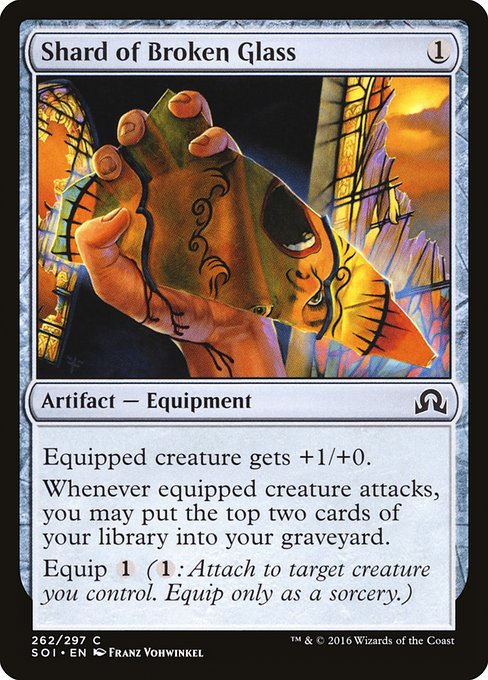
Image courtesy of Scryfall.com
Player Creativity as a Design Element in MTG
Magic: The Gathering has always thrived on the tension between a card’s raw numbers and the stories players craft around them. Some spells dazzle with silver-bullet power, others invite you to improvise, experiment, and chase a narrative arc you help write on the fly. The artifact equipment in Shadows over Innistrad is a perfect case study in how a tiny, thoughtfully placed decision can unlock a surprising amount of player creativity 🧙♂️. When a card allows you to buff a creature, trigger a secondary effect, and then ask you to think about timing and risk, you’re watching design philosophy in action: give players agency, keep the options crisp, and let the rest unfold in play patterns you can’t fully predict at the drafting table 🔥.
Consider the practical math and mood of this card: for one mana you get an artifact that equips for one, and it grants a modest +1/+0 to the creature it rides. That’s not a slam dunk; it’s a nudge. The beauty lies in the second line: “Whenever equipped creature attacks, you may mill two cards.” If you’re building a deck that wants to leverage the graveyard or simply enjoy the tension of information—what’s in your opponent’s library, what you’re drawing next—this moment-to-moment choice becomes part of your game plan. The milling is optional, which is a deliberate design decision that invites you to weigh tempo against mulch-deck strategy, and it keeps the option lanes open for both control-minded and creature-forward players 🧩.
One of the most elegant design moves here is the sorcery-speed requirement for equipping. You can’t instantly bolt a new piece of hardware onto a creature after it swings; you must plan ahead or rely on another spell to untap a moment. This constraint nudges players toward sequencing and anticipation—two pillars of strategic play. It also preserves the mana curve’s integrity in a challenging way: you’re not paying for an immediate late-game swing; you’re investing in a potential turn later when the risk of milling two cards is offset by the board state and the top of your deck. That delicate balance is a tiny classroom on how to design interactive choices that feel meaningful without tipping into brute-force power 🔎.
- Low cost, high texture: A 1-mana artifact with Equip {1} sits in a sweet spot where it’s cheap enough to play early but layered enough to matter later.
- Equipped buff with a quiet payoff: +1/+0 is modest, but it complements aggressive lines and helps enable favorable attack triggers.
- Mill as a design lever: The optional mill two cards on attack creates a feedback loop with graveyard strategies and with the broader “mill” lexicon that players love to debate and explore 💎.
- Sorcery-speed equip constraints: Timing matters, which elevates deck-building from “play more stuff” to “engineer precise moments.”
- Colorless versatility: Being colorless makes it a flexible piece across many archetypes, a design philosophy that encourages cross-pollination in a set that already enjoys asymmetric mechanical motifs 🎲.
In the broader magic-design conversation, this card embodies how designers craft spaces for creativity rather than prescribing a single path to victory. It doesn’t force you to mill, and it doesn’t require you to become a milling mastermind to use it effectively. It simply provides a tasteful nudge toward a graveyard-centric or tempo-oriented direction, depending on what your deck wants to do and when you choose to do it 🧭. That freedom—the room to improvise within a clean, legible framework—is the heartbeat of great set design.
The artwork, by Franz Vohwinkel, adds another layer of storytelling. The shards in the image evoke fragmentation and a world where every fragment can shape a larger whole. That theme mirrors the card’s mechanical philosophy: a small piece of silicon, bone, glass, or magic can tilt the timing of a battle and reveal hidden pathways in your deck. It’s a reminder that design is not just about numbers; it’s about atmosphere, about inviting players to imagine a world where tiny decisions echo loudly in the late game 🎨⚔️.
For players and collectors alike, the card’s common rarity makes it an accessible curiosity in both draft and casual play. The foil version will shimmer under the lights, but the core idea remains approachable: a compact, modular piece that can slot into a variety of board states and strategies. It’s a design micro-taste of a larger kitchen—an ingredient that creators can remix in countless ways as they draft and as they build out their homebrew strategies. The result is a card that feels tiny but resonates with a big: “What if I mill, and what if I mill now, and what else could I mill later, and why?” 🧲
As with all thoughtful game design, the value isn’t just what the card does; it’s how it invites conversation. It invites you to test hypotheses about milling thresholds, to shuffle through graveyard interactions, and to chase the rhythm of a tightly-tuned attack step. The payoff—an extra layer of decision-making—remains within reach for new players while still offering nuance for veterans who enjoy the subtleties of timing and deck-building. The result is a design that honors the community’s curiosity and embodies how player creativity drives MTG forward, one shard at a time 🔥.
And if you’re setting up the perfect table to brainstorm these ideas in real life, a breathable, glowing workspace helps. A Neon Rectangle Mouse Pad Ultra-thin 1.58mm Rubber Base is a chic companion for late-night deck-building sessions, letting you keep track of notes and top-deck predictions as you test lines in a digital or paper draft. A well-lit desk with a vibrant pad mirrors the energy of a well-tuned mill engine, making the creative process as satisfying as the win itself.
Neon Rectangle Mouse Pad Ultra-thin 1.58mm Rubber BaseMore from our network
- https://transparent-paper.shop/blog/post/how-to-set-up-affiliate-marketing-for-digital-downloads/
- https://blog.digital-vault.xyz/blog/post/subduing-the-board-imperial-subduer-inspired-archetypes/
- https://crypto-acolytes.xyz/blog/post/tracking-dex-volume-milestones-over-the-years/
- https://crypto-acolytes.xyz/blog/post/forecasting-the-next-wave-of-gaming-market-trends/
- https://blog.digital-vault.xyz/blog/post/blue-white-giant-near-aquila-informs-milky-way-models/